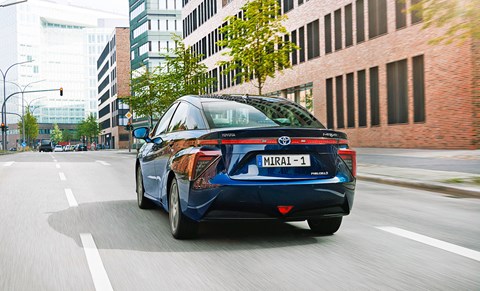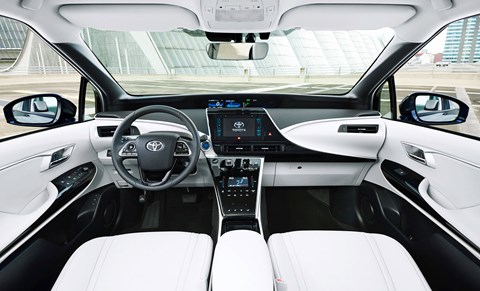► We drive the Toyota Mirai
► It’s a hydrogen fuel-cell-powered car
► A price tag of £66k though?
Hydrogen has been the fuel of the future for as long as anyone can remember. But now there are two – two! – hydrogen-powered cars in actual production. One is based on a previous-generation Hyundai soft-roader, which seems a slightly odd way of going about things; the other is this, the sensationally weird-looking, purpose-built Toyota Mirai four-seater saloon.
Mirai means ‘future’ in Japanese, which is nicely circular, though probably you’re already wondering why the future has to be so ugly. Even excusing Toyota with the shock of the new – and some of the design is functional, those large triangular vents at the front feed the cooling system – surely it didn’t have to be quite this… unconventional?
But let’s not get distracted. This is Toyota making the same sort of technological leap of faith it made nearly two decades ago with the Prius, except on a far grander scale – a Prius still relies on detonating petrol, after all. The Mirai’s under-floor fuel-cell stack splits hydrogen in a chemical reaction that creates electricity and water. The former drives the front wheels via the same electric motor used in the Lexus RX450h; the latter is recycled to humidify the fuel-cells or jettisoned as the Mirai’s only emission. There’s even a button for ejecting it manually, to prevent the thing inappropriately widdling on your garage floor.
That this is one of the most advanced hydrogen fuel-cell systems yet created practically goes without saying. Assisted by the addition of the nickel-metal hydride battery pack from the latest Toyota Camry Hybrid – as in a conventional hybrid, this powers the car alone at low speeds and boosts acceleration when required – the Mirai makes 152bhp and 247lb ft, and can travel up to 312 miles between fill-ups. Refuelling takes about three minutes.

It drives with the usual eerie competence of an alternative-fuel vehicle. In fact, it’s almost exactly like a particularly refined EV, with punchy rolling acceleration and slightly remote steering that’s especially vague about the straight-ahead. Soft suspension gives a comfortable ride prone to light chop, while having all the major weight low down in the middle of the platform means it dispatches corners with deceptive sprightliness. You aren’t going to be taking the H-bomb for a Sunday morning thrashing, but soon the only reminders you’re driving something really out of the ordinary come from the curious looks of innocent bystanders, the Star Trek shuttle interior, and the keening, artificially-generated noise – easily drowned out by the hi-fi.
Seem interesting? It is. Genuinely. And we should be mature about this and applaud Toyota for taking such a bold step when it expects just 50-100 European sales a year. The trouble is the same as it’s always been: the infrastructure, and the money. £66k will buy you plenty of Tesla, with far greater performance and more price-appropriate cabin quality. Yes, you’ll wait much longer for a Model S to recharge, but currently there are just three Mirai-suitable UK hydrogen stations – in Heathrow, Hendon and Swindon – which doesn’t sound like much of a day out.
More are coming, but you’ll have to be a far-thinking and selfless private buyer indeed to join the hydrogen journey this early. We salute you.

The specs: Toyota Mirai
Price: £66,000
Engine: Toyota Fuel-Cell System, 152bhp, 247lb ft
Transmission: single-speed, front-wheel drive
Performance: 9.6sec 0-62mph, 111mph, 0.76kg of hydrogen/100km, 0g/km CO2
Weight: 1850kg
On Sale: Now
Love: Hydrogen power is no longer science fiction
Hate: That the future has to look weird
Verdict: Totally convincing tech, no real way to use it. Yet
Rating: ***